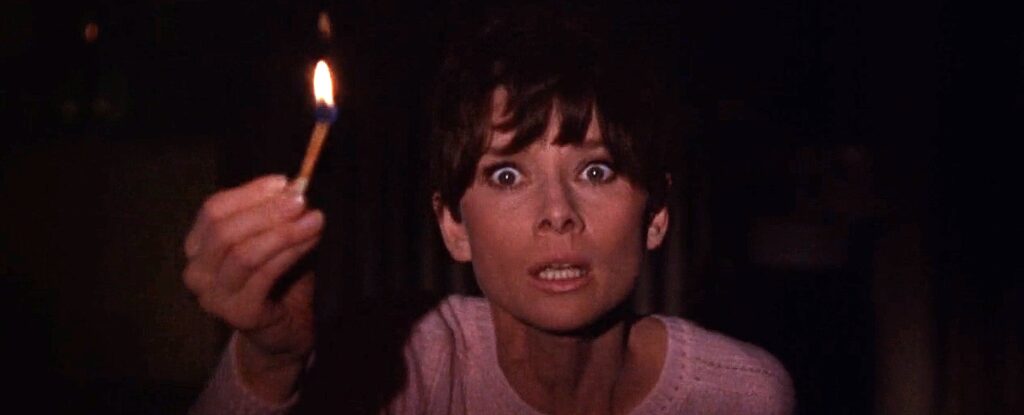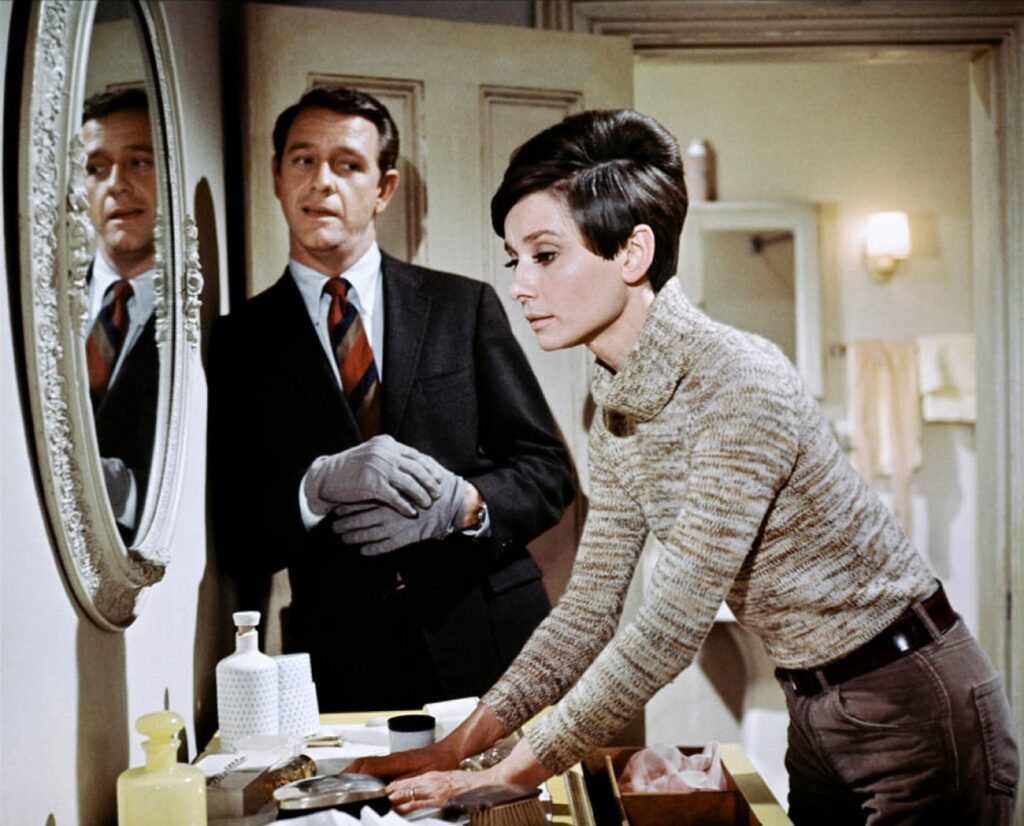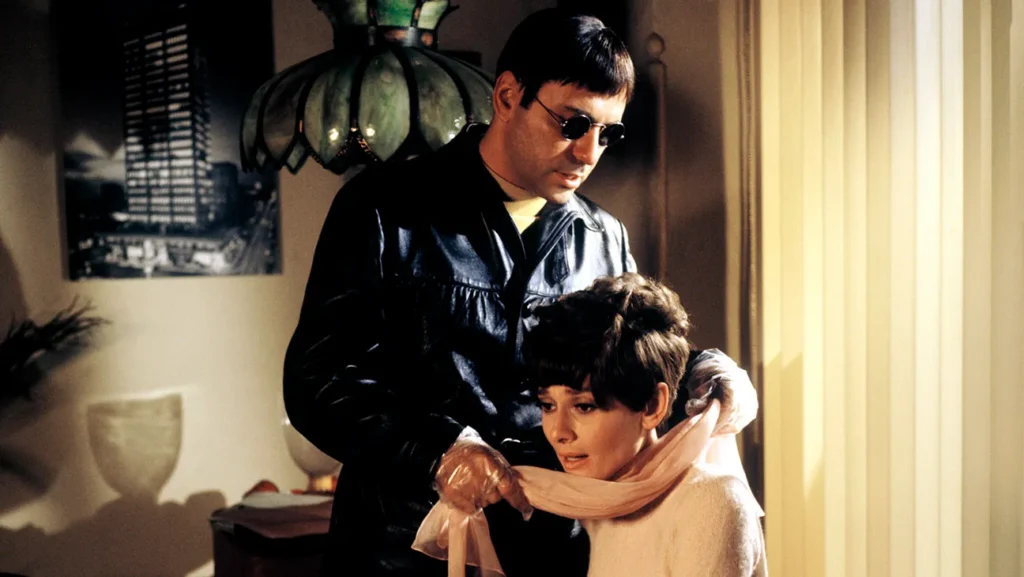Wait Until Dark (1967)

DIRECTOR: Terence Young
CAST: Audrey Hepburn, Alan Arkin, Richard Crenna, Jack Weston, Efrem Zimbalist Jr., Julie Herrod
REVIEW:
An adaptation of the 1966 play of the same name by Frederick Knott, written for the screen by Robert Carrington and Jane Howard Carrington, Terence Young’s suspense crime caper Wait Until Dark almost succeeds in spite of itself; the plot has more holes than Swiss Cheese, but a slick twisty-turny—-if far from airtight—-script keeps things moving along and reels the viewer in in spite of themselves, assuming they have a decent margin for suspension of disbelief.
The convoluted caper gets started when two small-time con men, Mike (Richard Crenna) and Carlino (Jack Weston), are recruited/blackmailed by a mysterious, sinister figure who calls himself Roat (Alan Arkin) to find a missing doll stuffed with heroin. The problem is, the doll has found itself into the unwitting possession of photographer Sam Hendrix (Efrem Zimbalist Jr.) and his blind wife Suzy (Audrey Hepburn). With her husband out of the house all day at his studio, the nefarious trio embarks on an elaborate con job to gaslight the blind housewife into unwittingly helping them find the doll that’s hidden away somewhere in her apartment. But complications arise when there’s no honor among thieves, and Suzy turns out to be more of a handful than expected.

After a slow start, Wait Until Dark seduces the viewer with the game of psychological cat-and-mouse that ensues between the three criminals and the housewife they’re conning. The three stage an elaborate act in which one plays an aggressive cop, one plays an old buddy of her husband’s, and one plays several characters, including a father and son double act. Our heroine is in a vulnerable position; Suzy, we learn, has been blind for about a year since a car accident and is attending blind school and still getting used to navigating her apartment. As one might expect, the blind wife, left alone in the house, is confused and increasingly frightened by multiple shady characters continuously coming and going and making harassing phone calls, pushing her into putting her trust in Mike, who is playing the role of the “good cop” (he poses as an old war buddy of her husband’s, using information he has gleaned from perusing the photographs on her walls to sell his story more convincingly). But Suzy is not completely helpless; she has a plucky sidekick of sorts in the little girl who lives upstairs (Julie Herrod) who she eventually enlists to be her eyes and ears, and the three criminals learn that her blindness is partially compensated for by other senses (she recognizes that a man playing two different “characters” is wearing the same shoes, and comes to question why the men are messing with the blinds to surreptitiously signal each other). The climactic showdown, when Suzy and Roat finally end up one-on-one under the same roof, has some nice touches in the cat-and-mouse game as they vie for the upper hand, complete with a “the villain is never really dead the first time” jump scare that apparently had 1967 audiences jumping in their seats, and building suspense with the conceit of having the screen intermittently go black, leaving us with only sounds to go by, until being illuminated again when one of the characters strikes another match (reportedly the studio was leery of this unconventional filming style, but it worked effectively to generate suspense among screening audiences).
While the screenplay has some nifty touches, it’s also got plot holes and characters doing unlikely things, and that dilutes some of the tension it’s trying to generate. The elaborate con job Roat devises to enlist Suzy’s unwitting help in finding the missing drug stash is arguably overly convoluted and contrived, especially given that it’s established early on that Roat has no problem resorting to much blunter and more expedient methods to get what he wants. There’s more problems. Why doesn’t Suzy lock the door when multiple shady characters keep coming and going? Why does Roat bother wearing disguises in front of a blind woman? Does the girl upstairs have any parents? Does Suzy ever consider fleeing to her apartment? Why doesn’t she send Gloria to the police station instead of the bus stop? Speaking of Gloria, her character undergoes a bit of a whiplash from throwing what’s—-from all we see onscreen—-an unwarranted tantrum to becoming Suzy’s plucky child sidekick (apparently Suzy’s earlier harsh treatment of her was elaborated on in the original play, making Gloria’s behavior better-motivated).

The original play starred Lee Remick as Suzy and Robert Duvall as Roat, the former of whom won a Tony Award for her performance, but rather than Remick reprising her role onscreen, the film adaptation was turned into a vehicle for Audrey Hepburn (partially courtesy of the influence of her husband Mel Ferrer who was one of the producers), who wanted to venture into new territory with a suspense thriller (although she had dipped her toe into somewhat similar waters with 1963’s twisty-turny Charade where she also played a woman being menaced and/or manipulated by an assortment of shady characters). Apart from her occasional tendency toward overdramatic histrionics, Hepburn is credible as a blind woman (reportedly she put a lot of work into striving for authenticity, including attending a blind school and even learning to read some braille). While Suzy might initially verge on a little too simple and trusting, we’re able to root for her because her blindness puts her in a vulnerable position but she eventually turns out to be more of a handful, both intellectually and physically, than anyone expects. Various leading men of the day turned down the role of the main villain Roat, not relishing making themselves look unlikable by terrorizing a blind woman, much less the beloved Audrey Hepburn. The man it eventually ended up with, Alan Arkin, might seem an unlikely choice for a sadistic killer, but he’s suitably menacing (albeit a little over-the-top), coming complete with a hidden switchblade and signature sunglasses he leaves on even in a dark apartment (in addition to naming Wait Until Dark one of his favorite films, Stephen King also named Arkin’s performance as Roat one of his favorite screen villains). Efrem Zimbalist Jr doesn’t have much screentime, but early opening scenes do a nice job establishing the affection between Sam and Suzy. Richard Crenna, Jack Weston, and Julie Herrod (the only cast member of the original 1966 play to reprise her role in the film adaptation) provide adequate support.
In the end, Wait Until Dark is perhaps not as frightening or suspenseful as it aims to be (though 1967 audiences might have disagreed), and the script has its share of plot holes, but it also has enough nice touches, a sympathetic enough vulnerable-yet-formidable heroine, and a hissable enough villain to succeed almost in spite of itself. It’s not a great suspense thriller classic, but for those with a somewhat generous suspension of disbelief threshold, it provides a diverting 108 minutes.
* * 1/2